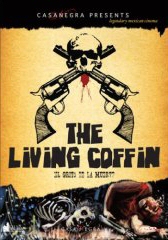
The second release of Casa Negra's double threat of classic, obscure Mexican carnage, The Living Coffin is a moody if uneven monster mash of clean-cut cowboy idols, bug-eyed spectres, and witchcraft. Alternately atmospheric, creepy, and silly, this feature isn't the best representative of this culture's unique contribution to the art of fear. However, it is fun, enjoyable in much the same way that the serials or programmer movies were at the Saturday matinee.
Mexican horror depended on classical literary figures as often as native folklore for their plots and atmosphere, taking advantage of their immediate thematic authenticity and aesthetic value. In The Living Coffin Edgar Allen Poe is credited as an inspiration, and his short story "The Premature Burial" an aspect of the major theme, but neither are relied upon enough to truly consider them as crucial to the story. Instead, we have a more routine tale of family betrayal, mock supernatural manifestations, and forced humor. The native folk tale of La llorna, the eternally cursed 'crying' woman (itself a Mexican symbiosis of the Jewish the ''Wandering Jew' and the Irish 'Ban-shee') is blended with Poe's principle fears of being buried alive, the death of youthful innocence, and the strange beauty of decay. The classical oat-opera Western flavor of the settings and characters gives the film an indefinable resonance, making the film worthwhile as curiosity if nothing else.
Cowboy (Gastón Santos) and his partner, Crazy Wolf (Pedro de Aguillón), unearth a weird stone figure depicting a crying woman. Seeking to discover its origin and purpose, they arrive at an odd ranch where a shapely young woman and her aunts fear the returning dead, living beneath a shadow of doom. The statue in question -- and another like it -- was created, it seems, by the deceased Clotilde (Carolina Barrett), and her revenant walks still, seen by locals as she sobs. What begins as a semi-gothic/supernatural premise suddenly becomes an odd stew of cowboy action and mystery as Cowboy and Coyote Loco become immersed in a conspiracy of faked spooks, bandits, and a secret gold mine. As the plot pulls further away from the occult and more firmly into kiddy matinee territory, bodies in Skeleton Swamp and bland humor pile up, and Cowboy must use his wits as well as his fist to stay alive.
Not very well written or directed, The Living Coffin is not without its merits. A rather somewhat uneven if occasionally intriguing concept is well served by moody direction if not good acting or story logic. Settings and mood are the saving grace of this genre hybrid. While devotees of the macabre and supernatural hoping for true occult manifestations will be disappointed by the eventual rationalization-away of the fantastic elements, and the picture itself suffers from trying to go into too many directions at once (at the expense of adequately reaching any one artistic goal), the enthusiasm of the cast and energy of the pacing keeps the action exciting enough -- and the mysteries involving enough -- to entertain. One cannot help but regret the Scooby Doo process of detection however, as the movie would have profited without it. The scenes of the ill woman's burial while in a comatose state -- the film's nod to Poe -- injects a much needed shot of suspense, as do the shots of a wandering corpse. In fact, the most iconic, frightful imagery is the lingering shots of the truly ghastly looking 'crying woman' who resembles more than a little Lucio Fulci's zombies in City of the Living Dead. While the final revelation of the 'mystery' is a cheat, the moments of feigned nightmarish fantasy leading up to the disappointing conclusion evoke an authentic sense of dread.
Casa Negra presents The Living Coffin in full frame with a generally clean transfer. One of the rare color horror films of this period in Mexico, the colors look rather good. The original Spanish language track is as clear as the former release, although the English option is marred by scratches and background noise. Again, both are decent, and the English dub is appreciated for its nostalgic quality. Extras for this release are barer than those included for Man and the Monster, limited to "Cast Biographies," a "Poster and Still Gallery," and an informative essay on the distinct genre of Mexican Western Horror Films by David Wilt (excellent in its discussion of this curious hybrid but a strain on the eyes, as the print is too small).
Review by William P. Simmons
| Released by Casa Negra |
| Region 1 - NTSC |
| Not Rated |
| Extras : |
| see main review |